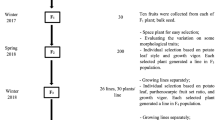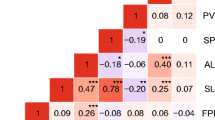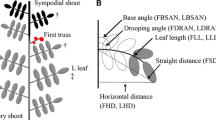Summary
Genetics of parthenocarpy in line RP 75/59 was tested under natural low temperature conditions, under which only seedless fruits were produced. Results were consistent with the hypothesis that three recessive genes with additive effects are responsible for parthenocarpy. Linkage studies, using 40 morphological marker genes located among all tomato chromosomes except chromosome seven, revealed linkage of one gene to diageotropica (dgt) located on chromosome 1 L site 152, and a second gene to yellow verescent (yv) located on chromosome 6 L site 34. Location of the third gene involved in parthenocarpy could not be determined. To calculate the power of the linkage tests, a simulation was carried out for three genetic models; the results are presented graphically in two figures.
Similar content being viewed by others
References
Jayakar, S.D., 1970. On the detection and estimation of linkage between a locus influencing a quantitative character and a marker locus. Biometrics 26: 451–464.
Nuez, F., J. Costa & J. Cuartero, 1986. Genetics of the parthenocarpy for tomato varieties ‘Sub-Arctic Plenty’ ‘75/59’, and ‘Severianin’. Z. Pflanzenzücht, 96: 200–206.
Philouze, J., 1983. Parthenocarpie naturelle chez la tomate. I. Revue bibliographique. Agronomie 3: 611–620.
Philouze, J., 1985. Parthenocarpie naturelle chez la tomate. II. Etude d'une collection variétale. Agronomie 5: 47–54.
Philouze, J. & B. Maisonneuve, 1978a. Heredity of the natural ability to set parthenocarpic fruits in a German line. Tomato Genet. Coop. Rep 28: 12.
Philouze, J. & B. Maisonneuve, 1978b. Etude de l'intérêt de l'Aptitude à la parthénocarpie naturelle. In: Rapport d'Activité 1977/78 Station d'Amélioration des Plantes Maraîchères d'Avignon Monfavet, INRA pp. 99–100.
Philouze, J. & B. Maisonneuve, 1978c. Breeding tomatoes for their ability to set fruit at low temperatures. In: ‘Genotype and environment in glasshouse tomato breeding’. Proc. Meeting Eucarpia Tomato Working Group, (Leningrad, USSR), pp. 54–64.
Philouze, J., H. Laterrot & B. Maisonneuve, 1980. I. Etude de l'Aptitude à la Parthénocarpie Naturelle. In: Rapport d'Activité 1979/80 Station d'Amélioration des Plantes Maraîchères d'Avignon Monfavet, INRA, pp. 91–99.
Preil, W., 1973. Zur Parthenokarpie bei Tomaten in Abhangichkeit vom Temperaturverlauf. Angew. Botanik 47: 135–140.
Preil, W., 1978. Zuchtziele bei Tomaten. Gemüse 14: 48–51.
Preil, W. & R. Reimann-Philipp, 1969. Untersuchungen über die Einflusse verschiedener Umweltfaktoren auf die Funktionsfähigkeit der Pollen von Tomaten (Lycopersicon esculentum Mill.) insbesondere solcher mit erblicher Neigung zur Parthenokarpie. Angew. Bot. 432: 175–193.
Soller, M., T. Brody & A. Genizi, 1976. On the power of experimental design for the detection of linkage between marker loci and quantitative loci in crosses between inbred lines. Theor. Appl. Genet. 47: 35–39.
Author information
Authors and Affiliations
Rights and permissions
About this article
Cite this article
Vardy, E., Lapushner, D., Genizi, A. et al. Genetics of parthenocarpy in tomato under a low temperature regime: I. Line RP 75/59. Euphytica 41, 1–8 (1989). https://doi.org/10.1007/BF00022404
Received:
Issue Date:
DOI: https://doi.org/10.1007/BF00022404




